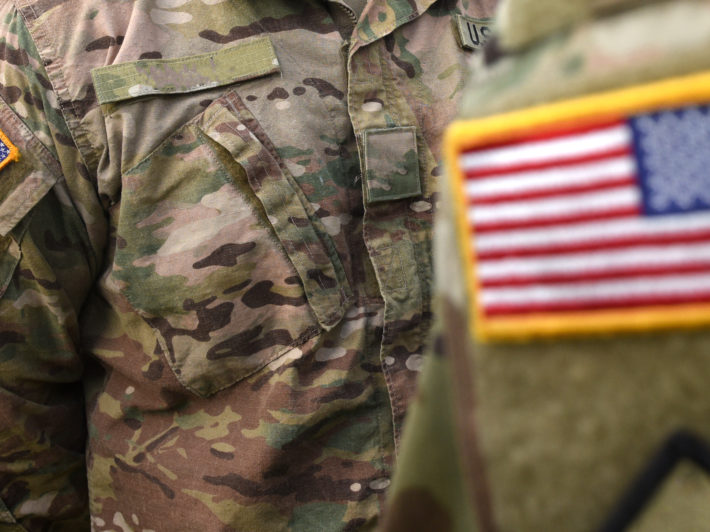
by Bianca Garilli, ND
Among the general US adult population, obesity rates (BMI >30 kg/m2) were nearly 40% in 2015-2016 and have continued to rise over recent years.1 This growing epidemic has spared virtually no demographic in the country, including the active duty military and military veteran populations.1
Active duty military obesity rates and consequences
Within the active duty ranks, obesity rates have climbed from 5% in 1995 to 12.7% in 2008.2 Although lower than the general population, the observed increase demands pause for further consideration, particularly in a population where maintaining rigorous physical fitness standards are both mandated and critical for mission success. Danger of failing physical fitness standards while on active duty may lead to a variety of downstream consequences affecting both the individual and the organization as a whole.
For one, an “unfit” service member is in jeopardy of being non-deployable and/or relieved of active duty status. Knowing this potential, individuals on the cusp of not meeting these guidelines may take matters into their own hands by seeking out and participating in unhealthy weight loss practices including harmful eating patterns and utilizing over-the-counter and prescription medications.3
Moreover, from an organizational standpoint, obese service members may jeopardize the mission, leading to potential increases in injuries and mortality on the battlefield.4-5 Failing to maintain standards and jeopardizing unit safety also increases potential risk of harassment of the obese individual from other service members.6
Veteran obesity rates and consequences
As the active duty armed services struggle with service members’ rising BMIs, the military veteran community has identified a similar challenge although more massive in nature. In a recent article published in the Journal of Psychiatric Research, the study’s authors penned the following:7
“Studies of the prevalence of obesity in the entire US military veteran population, regardless of VHA* user status, revealed that the prevalence of obesity among military veterans was 25.1%. Research based on the VHA data suggest a much higher prevalence of obesity (32.9%-41%). One recent study reported that obesity rate varies across 140 VHA sites and sometimes reached 49%, with even higher rate among veterans under age 65 (48%), among racial minorities (51%), in a subpopulation with medical and psychiatric co-morbidity (women with schizophrenia 56%), and patients with diabetes (68%).”
This particular article went on to report their findings from a study undertaken to provide an update on obesity statistics in the US veteran population. The hypothesis was that obesity prevalence would be higher than previously reported across specific demographics, including younger veterans, racial/ethnic minority groups, those with poor physical and mental health, more sedentary lifestyles, and reduced quality of life.7 Data for this study was collected from the national representative survey of 3157 US veterans conducted in 2011.7 Participants were separated into a non-obese group (BMI <30 kg/m2) containing 2100 individuals, 67.3% veterans and obese group (BMI ≥30 kg/m2) containing 1022 individuals, 32.7% veterans. Other demographics info: 89.9% of veterans in this study were male; 76.2% white, and 75.7% married.7
After analyzing the data from these two groups, it was found that in comparison to the non-obese veterans, obese veterans were:7
- Younger
- More likely to be non-white
- Had completed some college
- Not working
- Resided in the Southern or Midwestern regions of the US
- Have a greater household size
- More likely to use the Veterans Affairs (VA) for their primary healthcare services
- Diagnosed with a greater number of medical conditions including arthritis, chronic pain, diabetes, heart disease, high cholesterol, hypertension, kidney disease, sleep disorder, migraines, rheumatoid arthritis, and traumatic brain injury
- More likely to have reported experiencing physical or other emotional trauma as a child or adult
- More likely to screen positive for: lifetime post-traumatic stress disorder (PTSD), lifetime and current mental health treatment, nicotine dependence, and poor sleep quality
- Less likely to engage in active lifestyles
- More likely to experience reduced health-related functioning and lower quality of life
In all, the estimated prevalence of obesity of US veterans in this study was 32.7%, with no significant difference between male or female veterans.7
Weight loss inside the VHA system
There are a variety of reasons these findings are important and why this topic should be at the top of the federal government, Department of Defense (DOD) and public health organization agendas. For example, it has been shown that veterans with obesity will require a higher level of intervention, leading to a higher cost of healthcare over a lifetime than their non-obese counterparts.8 If the veteran is being followed and treated by the VHA, these costs will be shouldered by the VA. Among those veterans who receive their care at the VHA, the overweight and obesity rates are a staggering 37% and 41%, respectively.9 The future potential costs are enormous barring improved solutions and successful execution on these plans.9
The VHA currently runs the largest nationally disseminated weight control program in the US called the MOVE! Weight Management Program for Veterans (“MOVE!”), which was implemented across all VHA locations in 2005.7,10 This program incorporates individual or group counseling sessions along with encouraging behavioral changes through increased physical activity, goal setting, and mindful eating, with dietary education being a critical component of the program.10 MOVE! has been shown to be successful on an individual level, but when viewed from the larger veteran population that is receiving care from the VHA, the program has not been effective in stemming the tide of rising obesity within its ranks, since the obesity rate has continued to grow among VHA-using veterans from 25% in 2000 to 41% in 2017.7
Digging deeper, MOVE! has been shown to support veterans without mental health conditions more successfully than those with mental conditions, especially PTSD, leading thought leaders to discuss the needs for developing additional resources that combine weight loss with mental health components.11
Weight loss in veterans outside of the VHA system
While MOVE! has been a major step for targeting obesity in the VHA, nearly 2/3 of all US veterans do not receive their healthcare within the VHA system but rather see healthcare providers (HCPs) in their local communities or do not receive regular healthcare visits at all.12 Often the mental and physical healthcare needs of veterans is different than that of the general public, and not all community based HCPs are capable of delivering this type of personalized care. A recent RAND publication reported the results from a survey of 746 community-based HCPs in New York state, finding that “only 2.3% met all criteria for effectively serving the veteran population”.13 The areas that were found to be most deficient included providers unfamiliar with military culture, screening for military affiliation, or for conditions common among veterans.13
As additional information on the status of veterans’ obesity and overall healthcare needs emerge, coupled with the current available options, a common theme emerges – there is a large gap and need for additional research and program development in this area. This is particularly true for the area of obesity prevention and treatment in the veteran population receiving healthcare both within and outside of the VHA system.
Summary
- Effective and research-based programs targeting obesity prevention and treatment are required in the active duty and veteran healthcare spaces
- Obesity levels are quickly rising in both the active duty and veteran populations
- The VHA’s MOVE! program is successful on an individual level but has not been shown to impact the population on a larger scale and may not effectively address the individual mental health needs of obese veterans
- Future weight loss programs should combine mental health aspects within the curriculum as mental health conditions often accompany weight problems in the veteran population
- Successful weight loss programs specific to the needs of military veterans are needed in local community based healthcare facilities, where up to 2/3 of veterans may be receiving their healthcare services
*VHA = Veterans Health Administration
Citations
- CDC. Adult obesity facts. https://www.cdc.gov/obesity/data/adult.html. Accessed October 12, 2018.
- Reyes-Guzman C et al. Overweight and obesity trends among active duty military personnel: a 13-year perspective. Am J Prev Med. 2015;48(2):145–153.
- Bodell L et al. Consequences of making weight: a review of eating disorder symptoms and diagnoses in the United States military. Clin Psychol. 2014;21(4):398–409.
- Military.com. Too fat to fight: military threatened by childhood obesity. https://www.military.com/daily-news/2017/10/15/too-fat-to-fight-military-threatened-by-childhood-obesity.html. Accessed October 12, 2018.
- The Community Guide. 2017 annual report to congress: providing science to support military readiness and resilience. https://www.thecommunityguide.org/sites/default/files/assets/2017-congress-report-full.pdf. Accessed October 12, 2018.
- Schvey N et al. Weight stigma among active duty U.S. military personnel with overweight and obesity. Stigma and Health. 2017;2(4):281–291.
- Stefanovics E et al. The physical and mental health burden of obesity in U.S. veterans: results from the National Health and Resilience in Veterans Study. J Psychiatr Res. 2018;113:112-119.
- Healio. Obesity increases cost of care by $8000 per patient in VA study. https://www.healio.com/endocrinology/obesity/news/online/%7B5018be2c-35d4-4b80-9ccb-814d64588c35%7D/obesity-increases-cost-of-care-by-8000-per-patient-in-va-study. Accessed October 12, 2018.
- Breland J et al. The obesity epidemic in the veterans health administration: prevalence among key populations of women and men veterans. J Gen Intern Med. 2017;32(1):11–17.
- Arigo D et al. Veterans health administration’s MOVE! weight management program: primary care clinician’s perceptions of program implementation. Military Medicine. 2015;180(10):1027.
- Hoerster K et al. Weight loss after participation in a national VA weight management program among veterans with or without PTSD. Psychiatr Serv. 2014;65(11):1385-1388.
- Bagalman E. Congressional Research Service. The number of veterans that use VA health care services: a fact sheet. 2014. https://fas.org/sgp/crs/misc/R43579.pdf. Accessed October 12, 2018.
- Tanielian T et al. Ready or not? Assessing the capacity of New York state health care providers to meet the needs of veterans. Santa Monica, CA: RAND Corporation, 2018. https://www.rand.org/pubs/research_reports/RR2298.html. Accessed October 12, 2018.
Bianca Garilli, ND, USMC Veteran
Dr. Garilli is a former US Marine turned Naturopathic Doctor (ND). She works in private practice in Northern California and consults with naturopathic and Functional Medicine leaders, including the Institute for Functional Medicine and Metagenics. She is passionate about optimizing health and wellness in individuals, families, companies and communities- one lifestyle change at a time. Dr. Garilli has been on staff at the University of California Irvine, Susan Samueli Center for Integrative Medicine and is faculty at Hawthorn University. She is the creator of the Military and Veteran Health Initiative and is the current Past-President of the Children’s Heart Foundation, CA Chapter.




